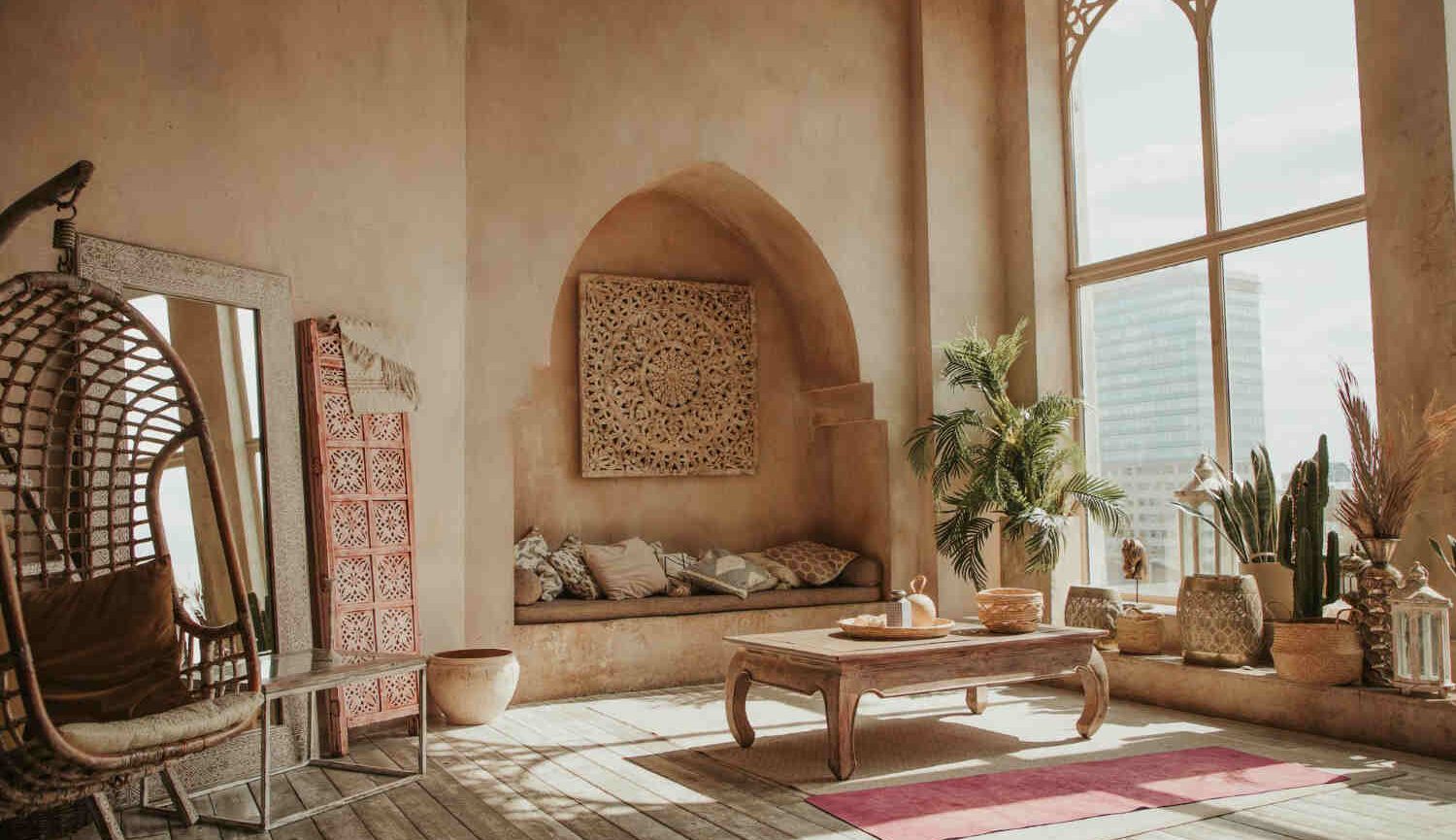A unique and mesmerizing blend of interior design unfolds, where the rich tapestry of local Emirati culture seamlessly interweaves with global design trends in the UAE. This fusion is not just an artistic endeavor; it reflects the UAE’s emergence as a cosmopolitan nexus, attracting influences from every corner of the globe. The commercial interior design landscape in the UAE, particularly in bustling centers like Dubai and Abu Dhabi, stands as a testament to this cultural and aesthetic amalgamation.
Here, traditional Arabian motifs merge with contemporary design philosophies, creating spaces that are both globally resonant and deeply rooted in local heritage. The UAE’s position as a global hub, bolstered by its rapidly diversifying economy and international population, plays a pivotal role in this dynamic fusion of styles, making it an epicenter of cross-cultural interior design innovation.
The Roots of Emirati Design Aesthetics
The traditional Emirati design aesthetic is a rich narrative woven through the history and heritage of the UAE. Fundamental elements such as intricate Islamic patterns, bold geometric shapes, and a palette inspired by the desert landscape form the core of this aesthetic. These designs are deeply entrenched in the history of the region, often serving as symbols of the local culture, environment, and religious beliefs.
In modern commercial spaces, these traditional elements are being reinterpreted and preserved with a contemporary twist. For instance, the majestic Islamic arches and intricate latticework are now seamlessly integrated into the sleek and minimalist layouts of modern businesses. This approach not only honors the historical significance of these elements but also ensures their relevance in today’s architectural context. By doing so, commercial spaces in the UAE become a canvas that reflects the past while embracing the future, creating environments that are culturally rich and visually captivating.
Global Influences on UAE’s Commercial Design Scene
The commercial interior design scene in the UAE is markedly influenced by a variety of global trends. These influences create a diverse and dynamic design landscape, which is evident in the region’s commercial spaces.
One notable global influence is Scandinavian minimalism, known for its simplicity, functionality, and clean lines. This style complements the ornate details of traditional Emirati design by offering a balance through its understated elegance. Another influence is Japanese Zen, which brings a sense of tranquility and naturalism to interiors. The incorporation of Zen elements like natural wood, stone, and plants adds a peaceful and organic feel to the otherwise bustling commercial environments.
Other global styles that leave their imprint include the bold and vibrant colors of Mediterranean design, the industrial-chic aesthetic popular in many Western countries, and the opulent luxury often seen in European designs. Each of these styles contributes to a rich tapestry of design in the UAE, making its commercial spaces not just places of business, but also hubs of global design excellence and cultural exchange. The result is a distinctive style that is both international in its appeal and uniquely Emirati in its essence.
- The Art of Blending Cultures in Design
The fusion of global design trends with Emirati aesthetics in UAE’s commercial spaces is a thoughtful process that reflects both cultural respect and contemporary appeal. It involves integrating modern design elements like minimalism or industrial chic with traditional Arabic patterns, textures, and color schemes. This blend creates spaces that are both globally appealing and deeply rooted in local culture.
Case Studies: Showcasing the Blend
Dubai Opera House: A prime example where contemporary architectural design meets traditional Islamic art. Its dhow-shaped structure is a nod to the UAE’s maritime heritage, while its sleek, modern interior speaks to Dubai’s cosmopolitan character.
Alserkal Avenue in Dubai: This cultural district blends industrial-style galleries with elements of traditional Emirati architecture. The use of courtyard spaces and wind towers (Barjeel) in contemporary art galleries brings a unique fusion of the old and the new.
- Sustainability and Cultural Integration
Sustainability in UAE’s commercial interior design goes beyond energy efficiency. It’s about selecting materials and practices that are environmentally friendly and culturally relevant. This involves using locally sourced materials, traditional building methods that are inherently sustainable, and modern technology to reduce the environmental footprint.
Examples of Sustainable Practices
Masdar City: Known for its sustainable architecture, Masdar City incorporates traditional Arabic design elements in a modern context. The use of low-carbon cement and recycled materials in construction is a testament to this commitment.
The Sustainable City in Dubai: Here, commercial spaces use solar energy and green building materials, while also reflecting traditional Arabic design motifs, ensuring a seamless blend of sustainability and culture.
- Color and Texture – The Language of Cultural Fusion
In the UAE’s commercial spaces, color and texture are used not just for aesthetic appeal but also to narrate cultural stories. Warm, earthy tones like ochre and terracotta, often found in traditional Emirati design, are paired with bolder, contemporary hues. Textures in fabrics and finishes often combine smooth, modern surfaces with more tactile, traditional materials.
Reflecting Cultural Narratives
Commercial spaces like hotels and shopping malls often use intricate Islamic geometric patterns alongside sleek, modern furnishings.
Textured surfaces such as carved wood and hammered metalwork are used in conjunction with polished concrete or glass, creating a dialogue between past and present.
- Furniture and Decor – A Global Melange
Furniture and decor in UAE’s commercial interiors are a testament to a global mélange. Designers often blend sleek, contemporary furniture with ornate, traditional pieces. This mix not only caters to functional needs but also to aesthetic preferences, reflecting a global sensibility while honoring local traditions.
Adapting Global Trends to Local Tastes
In luxury hotels and high-end commercial spaces, one might find Italian leather sofas sitting on Persian carpets, combining luxury with traditional craftsmanship. In cafes and lounges, modern Scandinavian furniture may be accented with traditional Arabesque lamps or cushions, creating cozy, culturally-rich spaces.
Challenges and Rewards of Cultural Fusion in Design
Balancing global trends with local culture presents unique challenges for interior designers in the UAE. One primary challenge is ensuring authenticity. Designers must deeply understand both Emirati culture and global design languages to create spaces that are not just aesthetically pleasing but also culturally respectful. Another challenge is avoiding clichés or stereotypical representations, ensuring that the fusion feels organic and not forced. Additionally, staying current with rapidly evolving global trends while maintaining a strong local identity can be demanding, requiring continuous learning and adaptation.
Despite these challenges, the fusion of global styles with local culture in commercial interior design brings numerous rewards. This blend often results in innovative and unique spaces that stand out in a competitive market. For businesses, this can mean attracting a broader clientele who appreciate the richness and diversity of such designs. Moreover, these spaces can foster a deeper connection with local customers by reflecting their cultural heritage. This fusion also aids in preserving local artistry and craftsmanship, integrating them into modern designs, thus keeping cultural traditions alive in a contemporary context.
JR Interior Design: Where Global Trends Meet Emirati Tradition.
The cultural fusion in the UAE’s commercial interior design is more than just a trend; it’s a reflection of the nation’s evolving identity as a cultural melting pot. This blend of global and local elements in interior design not only showcases the UAE’s openness to international influences but also its deep-rooted pride in its heritage. By embracing both, UAE’s commercial spaces become vibrant showcases of diversity and innovation, reflecting the dynamic and multicultural essence of the country.
At JR Interior Design, we pride ourselves on creating spaces that beautifully embody this cultural fusion. Our team of expert designers is adept at blending global trends with the rich Emirati culture, crafting unique and meaningful environments for your commercial properties. We invite you to experience the elegance and diversity of our designs. Whether you are refurbishing an existing space or embarking on a new project, let JR Interior Design in the UAE guide you in appreciating and realizing the potential of cultural fusion in your commercial space. Contact us today and take the first step towards creating a space that truly stands out.



